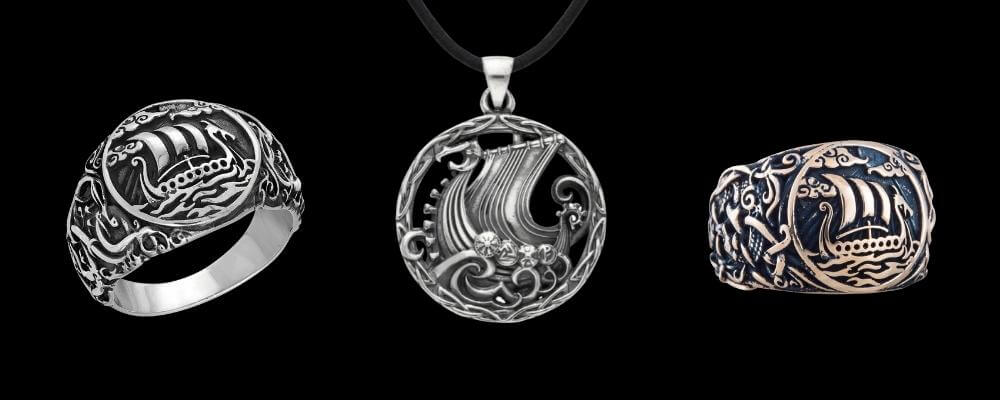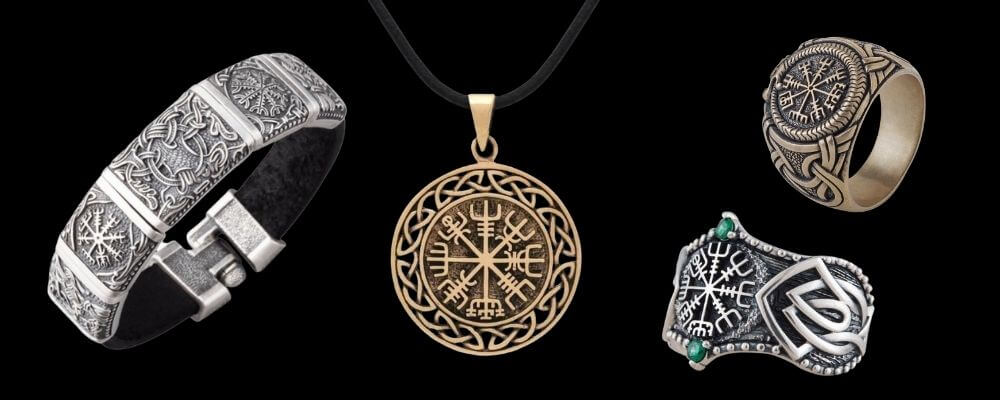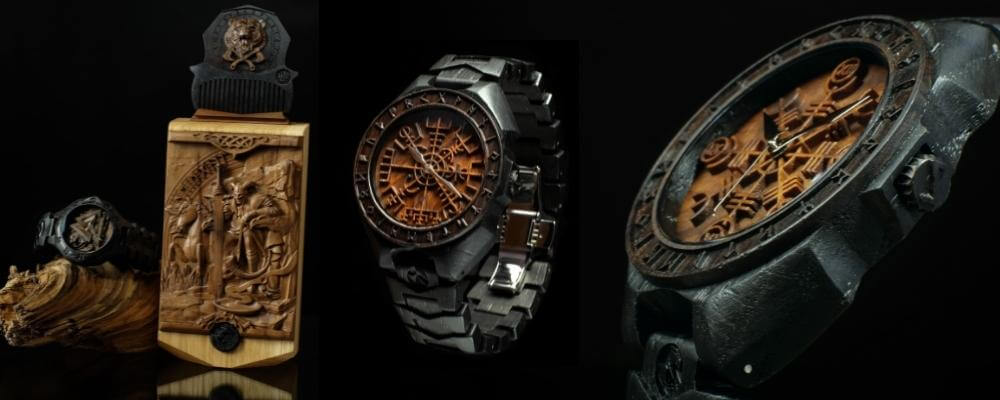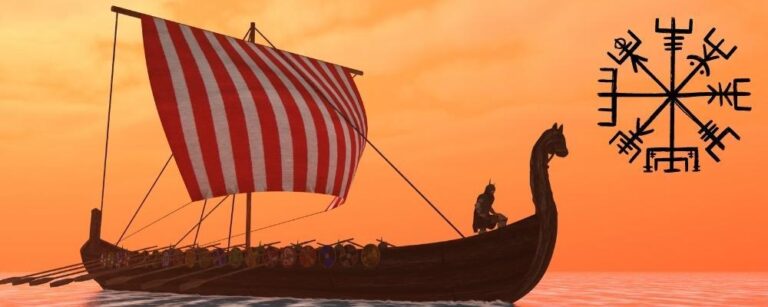One of the incredible things about the Vikings is how much of the world they discovered, more than 500 years before Christopher Columbus landed in America while looking for India – someone took a major wrong turn on the way!
Meanwhile, the Vikings not only raided across mainland Europe by land and sea, but they also successfully discovered and maintained sea routes between Scandinavia and England, Ireland, Scotland, and Wales, and discovered the uninhabited lands of Iceland and Greenland. They also landed in the Americas, in Newfoundland in Canada, more than 500 years before Columbus.
No maps known to have been drawn or used by Vikings survive. So, how were the Vikings able to do this without the aid of modern navigation technology and techniques?
There is some evidence that the Vikings used navigation tools that may have worked a little like modern-day compasses. They certainly also used magical means to steer their ships, including the symbol Vegvisir, often called the Norse Compass. Let’s take a look at both.

Viking Navigation
In the early days of exploration when the Vikings stayed mainly in Europe, they probably navigated primarily by keeping the shoreline, and familiar landmarks, within sight.
As they ventured further out to sea, they probably also had ways of observing the physical characteristics of the ocean to understand where they were. Things such as the depth of the water and the presence of birds and certain sea creatures would have been clear indicators that the Vikings learned to read.
In the TV series Vikings, we see Ubbe traveling with birds on board, and he would release the bird to see if there was land nearby. If the bird did not return, they could follow its path to find land. This technique is probably historically accurate.
The Vikings also probably used the stars to navigate, like sailors for millennia, though they have left no written record of this activity.
More important than the stars, however, was probably the sun. The position of the sun at midday is one of the most effective ways to determine your latitude, and therefore if you are still on course.

We know that other contemporary cultures used tools such as astrolabes to measure latitude, but that this was by no means simple. Since the sun changes its height throughout the year, Arab sailors had extensive charts to help them determine their latitude on different days of the year. Again, there is no surviving evidence to indicate that the Vikings had such charts.
Nevertheless, the sagas do mention sunstones, which were designed specifically to illuminate the position of the sun on overcast days. This at least suggests that the sun was important. In the most famous story, King Olaf asks the hero Sigurd to determine the position of the sun behind dark clouds with no instrumentation. Sigurd does so, and King Olaf uses a sunstone to determine if he is correct.
However, again, no sunstones survive in the Viking archaeological record, and it is unclear what material these stones would have been made from, though many theories exist.

Viking Compass
However, if the Vikings did use the sun to navigate, they must have had some kind of sun compass. Similar tools are known from other cultures. They use a simple vertical pointer on a horizontal surface that casts a shadow over an engraved line. The position of the shadow can indicate different latitudes, though again, the compass would have to be read differently at different times of the year.
The Vikings mainly set said between May and November, as these offered the best weather for sailing. This, at least, would have minimized the amount of sun chart information that a Viking sailor would need to retain in their heads.
Excavations at a Viking age farm in Greenland have found the remains of part of a circular disk with carvings, which may have formed part of one of these sun compasses.
Vegvisir – The Norse Compaass
While we can’t be sure whether the Vikings used physical compasses, we do know that they used magical ones.
The Vikings believed that their runes were more than just an alphabet. As well as being able to describe the world, they believed that the runes, when used by a master, could shape the world.
This is consistent with the practices of the Vikings’ Germanic ancestors, who certainly practiced Rune magic. In the first century AD, the Roman author Tacitus observed Germanic tribesmen carving runes into sticks and throwing them onto the ground as a form of divination. The same practice is described in the Viking poem known as the Lay of Hymir when the chips are thrown into blood to read the future.
The Germanic ancestors or the Vikings also commonly carved certain rune combinations onto jewelry, to bless or protect the item. Similar items with runic inscriptions survive from Viking times, on tools, jewelry, amulets, bones, wood, and stone.

Viking runic magic is also described in the sagas. In the saga of Egil, the eponymous warrior encounters a farmer whose daughter is very ill. Investigating the situation, he discovers a whale bone with a crudely carved rune in her bed. This was probably placed there by a local boy trying to help the girl, but whose knowledge of the runes was limited. As a master of the runes, Egil was able to identify this as the source of her illness, destroy the rune and replace it with a different runic message that would help the girl.
Runic magic based on the Viking tradition continued to be practiced in Iceland well after the height of the Viking period. Some insight into how they used the runes to conduct magic, and therefore how their Viking ancestors probably used the runes for magical purposes, survives in a number of magical grimoires dating from between 1400-1800.
The magic described in these texts is based around Galdrastafir, which are runic staves. Hundreds of them are known and they were used for a variety of purposes. Vegvisir, the Norse Compass, is one of those staves.

This symbol is first recorded in the Huld Manuscript, compiled by Geir Vigfusson in the 19th century. It depicts the Vegvisir symbol, which means “that which shows the way”, combining “vegur” which means way, with “visir”, which means pointer.
The symbol is composed of eight staves, each ending with different symbols. It has been speculated that each symbol represented one of the cardinal directions, much like a compass. It has also been suggested that each represents one of the nine worlds of Norse mythology, with the center point being Midgard, the location of the human subject of the spell.
The Huld Manuscript says of the symbol that: “If this sign is carried, one will never lose one’s way in storms of bad weather, even when the way is not known”.
While there is no surviving archaeological evidence that Vegvisir was used during the Viking age, the Viking poem Sigrdrifa does say that runes were sometimes carved onto the side of ships and oars. This may have been Vegvisir, or an earlier symbol on which the later Icelandic Wayfinder symbol was based.
What Do You Think?
What do you think? Did the Vikings rely on sun compasses, magical compasses, or a combination of the two in order to expertly navigate the sea?









I think you have described it correctly!
Iceland spar is a clear calcite that will fluoresce under UV light. Possibly this is the fabled sun stone, as UV light could penetrate cloud
I agree, it seems a likely possibility. It is just so strange that none are found among Viking archaeological remains. Maybe they were just too valuable to bury with the dead.